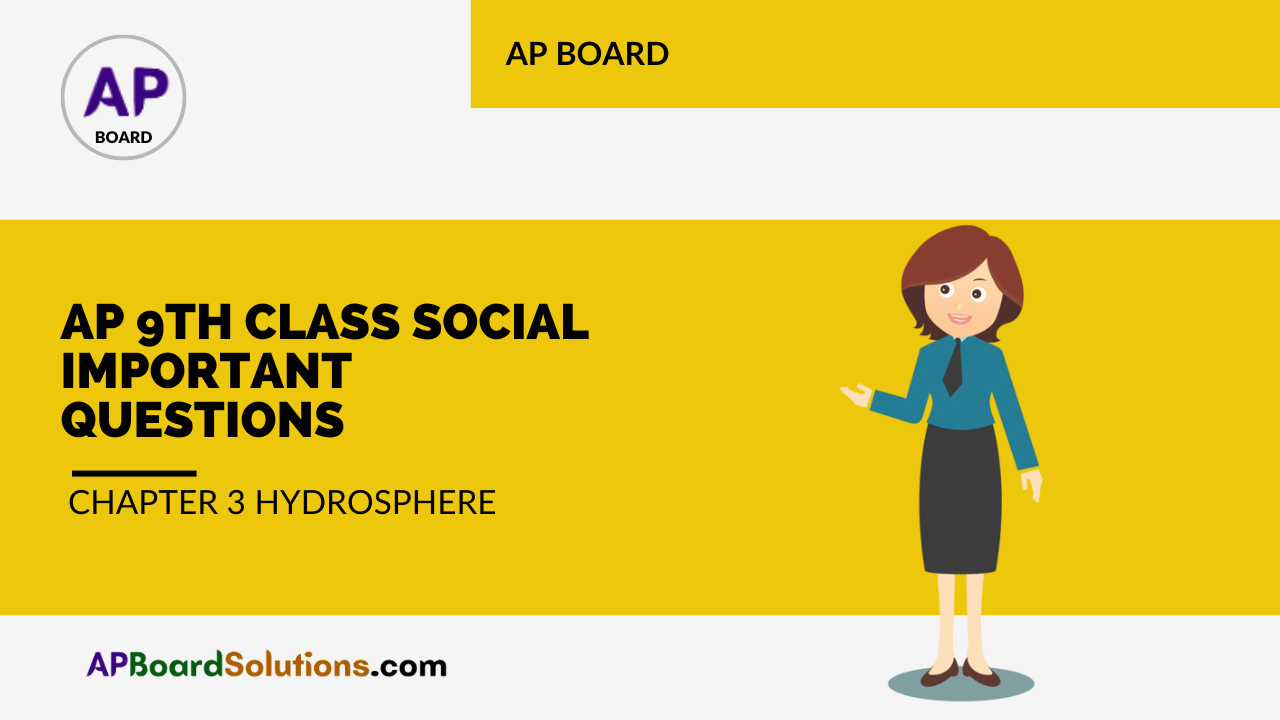These AP 9th Class Social Studies Important Questions 3rd Lesson Hydrosphere will help students prepare well for the exams.
AP State Syllabus 9th Class Social 3rd Lesson Important Questions and Answers Hydrosphere
9th Class Social 3rd Lesson Hydrosphere 1 Mark Important Questions and Answers
Question 1.
How are we polluting oceans today? (SA-III: 2016-17)
Answer:
We are polluting oceans today by dumping plastic, other forms waste and other industrial waste.
Question 2.
How can you appreciate the oceans as resources? (SA-II: 2017-18)
Answer:
- Ocean waves are used for generating power.
- Ocean floor is mined for oils.
- Oceans also provide with gems and pearls.
Question 3.
Write any two factors that affect the salinity of oceans. (SA-II: 2018-19)
(OR)
Write any two factors which effect salinity in water bodies? (SA-I: 2018-19)
Answer:
Salinity in water bodies is affected by evaporation, precipitation, ice formation, ice melting and temperature also.
![]()
Question 4.
Give any two examples of warm ocean currents. (SA-I: 2019-20)
Answer:
Two examples of warm ocean currents :
(a) Gulf stream,
(b) Kuroshio
9th Class Social 3rd Lesson Hydrosphere 2 Marks Important Questions and Answers
Question 1.
 (SA-I: 2019-20)
(SA-I: 2019-20)
a) Water distribution on earth
b)Fresh water consumption by humans
a) What percentage of the total water on the Earth is available for consumption?
Answer:
0.75% or 2.5%
b) Which activity of humans need maximum water?
Answer:
Agriculture.
9th Class Social 3rd Lesson Hydrosphere 4 Marks Important Questions and Answers
Question 1.
Describe the stages of water cycle.(SA-II: 2017-18)
(OR)
Explain various stages of Hydrological cycle. (SA-I: 2018-19)
(OR)
Draw the hydrological cycle and describe the stages involved in it.
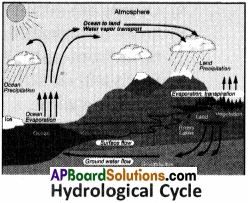
Answer:
There are six stages of water cycle. They are –
a) Evaporation :
- The process by which water changes from liquid to gas by using sun’s energy is called evaporation.
- Land, lakes, rivers and oceans send up a steady of water vapour and plants lose water to the air through transpiration.
b) Transportation :
- The movement of water through the atmosphere specifically from over the ocean to land in the form of clouds is transportation.
- Clouds are propelled from one place to another by either the jet stream, surfaces based circulations like land and sea breezes or other mechanisms.
c) Condensation :
The transported water vapour eventually condenses forming tiny droplets and clouds.
d) Precipitation :
- The primary mechanism for transporting water from the atmosphere to the surface of the earth is precipitation.
- When the clouds meet cool air over land precipitation is triggered in the form of rain, sleet or snow and thus water reaches the ground.
e) Run off:
- Most of the water which returns to land flows down hills as run off.
- Some of it penetrates into the land and charges ground water while the rest, as river flow, returns to the oceans where it evaporates.
f) Groundwater :
Under special circumstances, groundwater can even flow upward in artesian wells.
![]()
Question 2.
| Rank | Ocean | Notes |
| 1. | The Pacific ocean | Separates Asia and Oceania (Australia, New Zealand, Papuva, New Guinia together) from the Americas. |
| 2. | The Atlantic ocean | Separates the America from Europe and Africa. |
| 3. | The Indian ocean | Washes upon Southern Asia and separates Africa and Australia. |
| 4. | The Antarctic ocean (Southern ocean) | Sometimes considered an extension of the Pacific, Atlantic and Indian oceans which encircles Australia. |
| 5. | The Arctic ocean | Sometimes considered a sea of the Atlantic, which covers much of the Arctic and washes upon North America and Eurasia. |
Read the above table and answer the following questions. (SA-II: 2017-18)
1. Which ocean is also known as Southern Ocean?
2. Which ocean separate the America from Europe and Africa?
3. Which continents are separated by the Indian Ocean?
4. What are the land masses in Oceania?
Answer:
- Antarctic ocean is know as Southern ocean.
- The Atlantic ocean separates the America from Europe and Africa.
- The Indian ocean washes upon Southern Asia and separates Africa and Australia.
- Australia, New Zealand, Papua New Guinea are the land masses in Oceania.
Question 3.
“Water is considered a renewable resource”. Explain this statement.” (SA-I: 2019-20)
Answer:
- Water is considered a renewable resource because it cycles through the Earth system.
- It falls as precipitation.
- Then gets absorbed or run off.
- If it is absorbed, it can go deep into the ground or it can be taken up by plants.
- Plants return water to the atmosphere through transpiration.
- The water that goes deep into the ground can eventually run off into surface bodies of water like lakes and streams.
- The water that runs off can be evaporated, or it can run into lakes and streams.
- The water in lakes and streams can be evaporated, returning it to the atmosphere, where it can precipitate again.
9th Class Social 3rd Lesson Hydrosphere Important Questions and Answers
Question 1.
What is an Ocean? Write a brief essay on the ocean.
Answer:
The huge water bodies are called Oceans. There are five oceans on the earth. They are the Pacific ocean, the Atlantic ocean, the Indian ocean, the Southern (Atlantic) ocean and the Arctic ocean.
The ocean basins are in many ways similar to the land surface. There are submarine ridges, plateaus, canyons and terraces. Ocean floor is simply divided into four layers. They are continental shelf, continental slope, deep sea plain and oceanic deep.
Ocean water is salty. Most of the salt in the oceans comes from land. Over millions of years rain, rivers and streams have washed over rocks containing the compound Sodium Chloride and carried into the sea. The total content of dissolved salts in sea water is called salinity. It is usually expressed as parts per thousand (PPT). Average salinity of the oceans is 35%0. The salinity of ocean water depends mainly on evaporation and precipitation.
The little variations in ocean temperature show great effect on land temperatures. South west monsoon in India is affected by ‘El Nino’ and ‘La Nino’. These are the effects caused by the changes in temperature in the Pacific ocean. Normally, the temperature in oceans varies from – 2°C to 29°C.
The general movement of a mass of water in a fairly defined direction over great distance is called an ocean current. Based on temperature ocean currents may be classified into cold currents and warm currents. Generally warm currents flow towards the poles, cold currents flow towards the equator. Centrifugal force, effects of winds, effects of precipitation, effect by solar energy are the causes of ocean currents.
Oceans have many uses for man. They are the store houses of fish. Oceans are the sources of Chlorine, Fluorine, Bromine and Iodine. Tides and waves of the oceans are the sources of renewable energy. Oceans are sources for rainfall. They act as international highways. Rock petroleum and natural gas are extracted under oceans. Minerals such as sand, gravel, manganese, copper, nickel, etc., are mined from oceans.
Thus without oceans Ijfe of man is impossible.
![]()
Question 2.
Describe the salinity of the oceanic water.
Answer:
- Ocean water is salty.
- Most of the salt in the oceans comes from land.
- Over millions of years rain, rivers and streams have washed over containing the compound Sodium Chloride (NaCl) and carried into the sea.
- The total content of dissolved salts in sea water is called salinity.
- The salinity of oceanic water depends mainly on evaporation and precipitation.
- In coastal regions salinity is influenced by the fresh water flow from rivers.
- In polar regions salinity is influenced by the process of freezing and thawing of ice.
- Salinity is usually expressed as parts per thousand (%0) or PPT.
- The average salinity of the oceans is 35%0.
- Lake Van of Turkey is the water body with the highest salinity.
Question 3.
Describe the temperature of oceanic water.
Answer:
- When compared to land the temperature on oceans does not show more variations.
- Ei Nino and La Nino are the effects caused by the changes in temperature in the Pacific Ocean.
- The activeness of South West monsoon in India is affected by Ei Nino and La Nino.
- The ocean temperature is influenced by latitudes, winds and ocean currents, unequal distribution of land and the change of seasons.
- Normally, the temperature in oceans varies from – 2°C to 29°C.
- The highest temperature is recorded in inland seas.
- The temperature is the highest in Red Sea, i.e. 38° C.
- As one goes deep inside the oceans, the temperature rapidly decreases for every 1 km and remains stable.
- The temperature is stable at the foot of ocean i.e., 1.8° C.
![]()
Question 4.
What are the ocean currents? How are they formed?
Answer:
1. The general movement of a mass of water in a fairly defined direction over great distance is called ocean current.
2.Causes that lead to the formation of ocean currents are :
a) Centrifuge! Force :
The centrifugal force at the equator is greater than that at the poles. The variation of these forces makes the equatorial water to move towards the poles.
b) Effect of Winds :
The stresses due to wind and the wind movement modifies the the theoretical direction of currents. Due to the frictional gliding of winds water is dragged along the wind direction. Thus a 50 miles per hour wind will produce a current whose velocity is 0.75 miles per hour.
c) Effect of Precipitation :
Since the level of sea is higher water moves north and south from the equator.
d) Effect of Solar Energy :
Heating by solar energy causes the water to expand near the equator. Hence near the equator the ocean water is about 8 cm higher in level than in the middle latitudes. This causes a very slight gradient and water tends to flow down the slope.
e) Salinity, density differences, melting of ice also affect the ocean currents.
Question 5.
How are the oceans useful to mankind?
Answer:
- Oceans are store houses for fish.
- Since early times man depended on oceans for food.
- Dogger Bank North Sea, Grand – bank, New found land are famous fishing regions.
- Chlorine, Fluorine, Bromine and Iodine are found in oceans.
- Tides and waves are non-renewable energy resources.
- Oceans are sources for rainfall.
- Oceans act as international highways.
- Sources for civilizations : Greek civilization, Rome civilization all flourished on banks of rivers and oceans.
- Rock petroleum, Natural gas are extracted under oceans.
- Oceans are mined for minerals, salt, sand, gravel, manganese, copper, nickel, etc.
Question 6.
Why is the earth called the blue planet?
Answer:
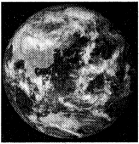
- Planet earth is called the ‘Blue planet’ due to the abundant water on its surface.
- About 71% of the earth is covered with water.
- If we look at earth from outer space, we can see the earth almost entirely blue.
Question 7.
What is the importance of continental shelf?
Answer:
- The continental shelf with depth up to 200 mts occupied about 7.6% of the oceans area.
- It is the border zone between land and sea.
- Continental shelf is most important to
a) Fish wealth is more in this region.
b) Rock petroleum, natural gas are found here.
c) Building sea port is possible here.
![]()
Question 8.
What are Oceans?
Answer:
The huge water bodies are called Oceans.
Question 9.
What is ocean current?
Answer:
The general movement of a mass of water in a fairly defined direction over great distance is called ocean current. –
Question 10.
What is meant by evaporation?
Answer:
Evaporation: The process by which water changes from liquid to gas by using sun’s energy is called evaporation.
Question 11.
What is meant by transportation?
Answer:
Transportation:
The movement of water through the atmosphere specifically from over the ocean to land in the form of clouds is called transportation.
Question 12.
Where do we find trenches? What is their significance?
Answer:
- Contrary to our expectations, most of the deepest trenches are not located in the midst of oceans.
- They are found more close to the continents.
- They are very significant in the study of plate movements.
Question 13.
Which part of ocean floor is suitable for building seaport? Why?
Answer:
- Continental shelf of ocean floor is suitable for building seaport.
- The continental shelf with depth upto 200 m.
- It is the border zone between land and sea.
- It will be useful in anchoring the ships.
![]()
Question 14.
Do you think the rain we get is in any way related to hydrological cycle?
Answer:
- Yes. I think the rain we get is related to hydrological cycle.
- It is a part of precipitation, which constitutes in hydrological cycle.
- It is the fourth stage of the six stages in hydrological cycle.
Question 15.
What are the factors that affect the movement of ocean currents?
Answer:
The factors that affect the movements of ocean currents are –
- The centrifugal force
- The winds
- The precipitation
- The solar energy
- Salinity
- Differences in density
- Melting of ice etc.
Question 16.
Write about continental slope.
Answer:
- The continental slope is spread from 200 mts to 3000 mts depths of oceans.
- It comprises of 15% of the ocean area.
- Submarine canyons are observed in this region.
![]()
Question 17.
Write about the classification of Ocean currents.
Answer:
1. Ocean currents may be classified on the basis of temperature as –
(a) Cold Currents
(b) Warm Currents
2. Ocean currents may be classified on the basis of speed as –
(a) a stream
(b) a drift
Question 18.
“From ail the sources of water reaching the earth, less than 1% of water is useful to man” – Interpret the statement.
Answer:
Of the total volume of water on earth only 2.75% is fresh water. Most fresh occurs in the form of permanent ice, snow locked up in the Antarctica and Arctic and in the mountain regions. The principal sources of water for human use are lakes, rivers, soil moisture and relatively shallow ground water basin. The usable portion of these sources is only about less than 1% of all fresh water.
Question 19.
“RF = RO + ET” – Explain the equation.
Answer:
- The total amount of water present on the earth surface remains constant but undergoes continuous transformation from water vapour to liquid.
- This equation is also called water balance equation.
- That means the amount of water received from rainfall is equal to the total amount of water runs off and the amount of water that is lost in evapotranspiration.
- Thus the equation Total Rain Fall = Total Run Off+Total water lost in Evapotranspiration.
Question 20.
in which ways oceans are being exploited by us, today?
Answer:
- Today oceans have also fallen victim to our exploitation.
- Many large fish like whales have been disappearing.
- Oceans have also become dumping ground for our plastic and other forms of faste.
Question 21.
Usually oceans have salinity of 35%. But being part of Atlantic ocean, how come Baltic sea has salinity of 3-15%?
Answer:
- Baltic sea is enclosed by Scandenavia (Norway, Sweden), Finland, Baltic countries and North European plain.
- It has major inflows from rivers like Oder, Vistula, Neva, Narva, Jome, Neman, Kemijoki and Dangava.
- Only outlets towards danist areas.
- As its coastal regions are in respect of fresh waters resulting in lower salinity.
![]()
Question 22.
Lake Van of Turkey experiences harsh winters with -300C. Why do you think its water never gets freezed?
Answer:
- Lake Van is fed by streams descending from surrounding mountains.
- It has no outlet, as outlet once present was closed by volcanic eruption.
- Water here is with a pH value of 9.7 – 9.8.
- It is situated at an altitude of 5380 ft.
- But because of its salinity of 330%, (oceans have 35% salinity) it is free from freezing.
Question 23.
The table below shows the descending order of the oceans in terms of size.
| Rank | Ocean | Notes |
| 1. | The Pacific ocean | Separates Asia and Oceania (Australia, New Zealand, Papuva, New Guinia together) from the Americas. |
| 2. | The Atlantic ocean | Separates the America from Europe and Africa. |
| 3. | The Indian ocean | Washes upon Southern Asia and separates Africa and Australia. |
| 4. | The Antarctic ocean (Southern ocean) | Sometimes considered an extension of the Pacific, Atlantic and Indian oceans which encircles Australia. |
| 5. | The Arctic ocean | Sometimes considered a sea of the Atlantic, which covers much of the Arctic and washes upon North America and Eurasia. |
1) What is the largest ocean on the earth?
Answer:
The Pacific ocean.
2) Which ocean is considered as the extension of three important oceans?
Answer:
The Antarctic ocean.
3) What is the smallest ocean on the earth?
Answer:
The Arctic ocean.
4) Which ocean separates America from Europe and Africa?
Answer:
The Atlantic ocean.
5) Where is the Indian Ocean?
Answer:
To the South of Asia.
Question 24.
“The activeness of South west monsoon in India is affected by El Nino and La Nino”. Prove the statement.
Answer:
- El Nino and La Nino are the names given to the changes in winds in the Pacific Ocean.
- El Nino and La Nino are formally called ‘The small boy’ and ‘The little girl’.
- La Nino and El Nino come about when the waters of the eastern and central Pacific Ocean along the equator become usually cold or warm.
- These changes in the Pacific produce swings in atmospheric pressure, winds, temperature and rainfall that have a global impact.
- For India La Nino is often a cause for concern because of its adverse impact on the South west monsoon.
- The El Nino on the other hand is often beneficial for the monsoon especially in the latter half of the season.
- Because of global warming the temperature of the western Pacific is influencing the effect La Nino.
| News Item : ELNINO may affect the monsoon : 4-8-2017 (BUSINESS STANDARD) The Indian Meteorological Department scaled down its full season forecast for the South west monsoon this year from normal to deficient, the first indication of a drought in several parts of the country. The Director General L.S. Rathore in an interview says though rains in August may be normal the intensity may decline in September. |
Question 25.
Can you say what the temperature at the foot of the Pacific ocean is?
Answer:
- Normally, the temperature in oceans varies from -2°C to 29°C.
- As one goes deep inside the oceans the temperature rapidly decreases for every 1 km and then it remains stable.
- The temperature is stable at the foot of the ocean, i.e. 1.8°C.
- Therefore the temperature at the foot of the Pacific ocean is 1.8°C.
Question 26.
“The government of Maldives held its first underwater cabinet meeting at a depth of 20 feet off the coast just north of the capital Male. Maldives wanted to attract the attention of the world to the dangers of global warming and sea-level rise. This is a matter of great concern not only for the Maldives but also for all the countries in the World”.
Basing on the information given above – frame a thought provoking question on the issue.
Answer:
What are the causes that lead to the sea level rise ? What should we do to prevent it?
Question 27.
Why do we call the earth as blue planet?
Answer:
- 71% of the earth is covered with water.
- Hence it appears as blue in the photographs taken from the moon.
- So we call the earth as blue planet.
![]()
Question 28.
Without oceans life of the man is impossible. Discuss it.
Answer:
- Oceans are international highways hence facilitate imports and exports among different countries.
- Oceans are sources of rainfall. Much of the evaporation takes place from oceans and comes to earth in the form of rainfall.
- They are the source of sea food which is staple food for some people.
- Oceans are warehouses of minerals like Petroleum, Natural Gas, Manganese etc., which are necessary for industrial development.
Hence life of the man is impossible without oceans.
Question 29.
Observe the map.
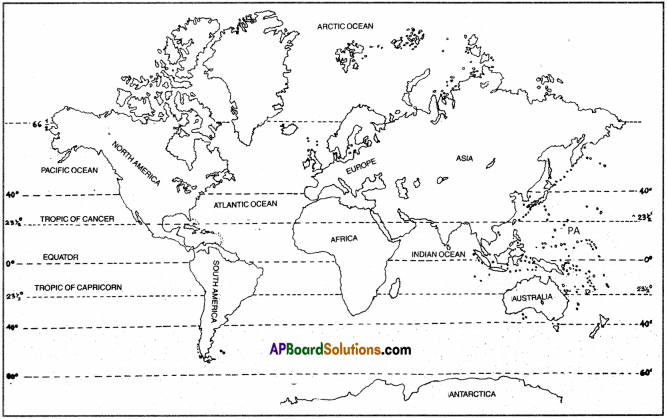
Now, answer the following questions.
1) Which ocean separates America from Africa and Europe?
Answer:
Atlantic ocean.
2) Name ocean that separates Africa and Australia.
Answer:
Indian ocean.
3) Which is the ocean that encircles Australia?
Answer:
Pacific ocean.
4) Which ocean is there to the south of India?
Answer:
Indian ocean.
Question 30.
Locate the following oceans in the world map given below.
1) The Pacific ocean
2) The Atlantic ocean
3) The Indian ocean
4) The Arctic ocean
5) The Antarctic Ocean
6) The Baltic sea
7) The Red sea
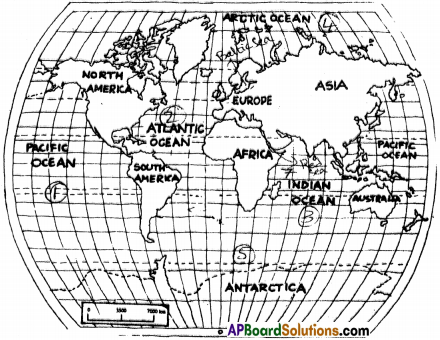
Question 31.
Describe any one impact of ocean currents for the region you live.
Answer:
The Indian Monsoon current refers to the seasonally varying ocean current regime found in the tropical regions of the nothern Indian ocean. The seasonally reversing open ocean currents that pass through south of India are referred to as the winter monsoon current and the summer monsoon current, alternately the north-east monsoon current and the southwest monsoon current.
India receives rainfall due to these currents.
![]()
Question 32.
Without oceans life of man is impossible. Discuss it.
Answer:
Throughout the history man is directly or indirectly influenced by the oceans. Oceans have many uses for man.
- Since early times man depended on oceans for food. Oceans are store houses for fish.
- Ocean is a source of valuable minerals. Chlorine, Fluorine, Bromine and Iodine are found in oceans.
- Rock petroleum, Natural gas are extracted under oceans.
- Oceans are mined for mineral salt, sand, gravel manganese, copper, nickel etc.
- Some biological products of oceans are also commercially used. For example, pearls taken from oysters are used in jewellery.
- Shells and corals have been widely used as source of building material.
- Tides and waves are renewable energy sources.
- Oceans are sources of rainfall.
- Oceans act as international highways.
- Many great civilizations such as Greek civilization, Rome civilization all flourished on the banks of rivers and oceans.
There are many more uses for man from oceans. Hence we can say without oceans life of man is impossible.
